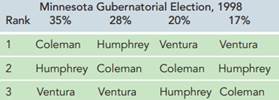Reference no: EM131831268
In the 1998 Minnesota gubernatorial election, there were three main candidates: Norm Coleman (the Republican), Jesse "The Body" Ventura (an Independent), and Hubert Humphrey (the Democrat). Although we can't know for certain, the voters probably ranked the candidates in a way similar to that found in the following table. The table tells us, for example, that 35% of the voters ranked Coleman first, Humphrey second, and Ventura third; and 20% of the voters ranked Ventura first, Coleman second, and Humphrey third; and so forth

a. Suppose the election is by plurality rule, which means that the candidate with the most first place votes wins the election. Who wins in this case?
b. In Challenges question 4, you were introduced to the Marquis de Condorcet. Today, voting theorists call a candidate a Condorcet winner if he or she can beat every other candidate in a series of 1:1 or "face-off" elections. Question 4 showed you that in some cases, there is no Condorcet winner. What about in the gubernatorial election of 1998?
c. A Condorcet winner beats every other candidate in a face-off. A Condorcet loser loses to every other candidate in a face-off. Was there a Condorcet loser in the 1998 Minnesota gubernatorial election (given the preferences we have estimated)?
Question
We mentioned that the median voter theorem doesn't always work, and sometimes a winning policy doesn't exist. This fact has driven economists and political scientists to write thousands of papers and books, both proving that fact and trying to find good workarounds. The most famous theoretical example of how voting doesn't work is the Condorcet paradox.
The Marquis de Condorcet, a French nobleman in the 1700s, wondered what would happen if three voters had the preferences like the ones in the following table. Three friends are holding a vote to see which French economist they should read in their study group. Here are their preferences:

a. They vote by majority rule. If the vote is Walras vs. Say, who will win? Say vs. Bastiat? Bastiat v. Walras?
b. They decide to vote in a single-elimination tournament: Two votes and the winner of the first round proceeds on to the final round. This is the way many sporting events and legislatures work. Now, suppose that Jean is in charge of deciding in which order to hold the votes. He wants to make sure that his favorite, Walras, wins the final vote. How should he stack the order of voting to make sure Walras wins?
c. Now, suppose that Claude is in charge instead: How would Claude stack the votes?
d. And Marie? Comment on the importance of being the agenda setter. (In case you think these examples are unusual, they're not. Any kind of voting that involves dividing a fixed number of dollars can easily wind up the same way-check for yourself! Condorcet himself experienced another form of democratic failure: He died in prison, a victim of the French Revolution that he supported.)

|
What is the amount that fashion must pay
: On April 6, 2014, Fashion Furnishings purchased $24,800 of merchandise from James's Imports, terms 2/10, n/45. On April 8, Fashion returned $2,400.
|
|
Part of the environmental scanning process
: When reviewing an organization as part of the environmental scanning process, what political and ethical factors must be taken into account and why?
|
|
Australian dollar call options at premium
: Bulldog, Inc., has sold Australian dollar call options at a premium of $.02 per unit, and an exercise price of $.89 per unit.
|
|
Why should a service organization worry about
: Why should a service organization worry about being world class if it does not compete outside its own national border?
|
|
Comment on the importance of being the agenda setter
: Suppose the election is by plurality rule, which means that the candidate with the most first place votes wins the election. Who wins in this case?
|
|
Management in respect to project planning
: How significant is project time management in respect to project planning--use the PMBOK® Guide to steer your discussion?
|
|
What is her cash flow under the current capital structure
: What is her cash flow under the current capital structure, assuming the firm has a dividend payout rate of 100 percent?
|
|
Bargaining behaviors of the participants
: Do you think the attitudes and bargaining behaviors of the participants in collective bargaining negotiations are more or less important in the final outcome
|
|
Upward on the corporate ladder
: Evaluate the principle of ethics as it applies to leadership and determine the role of ethics as you move upward on the corporate ladder.
|